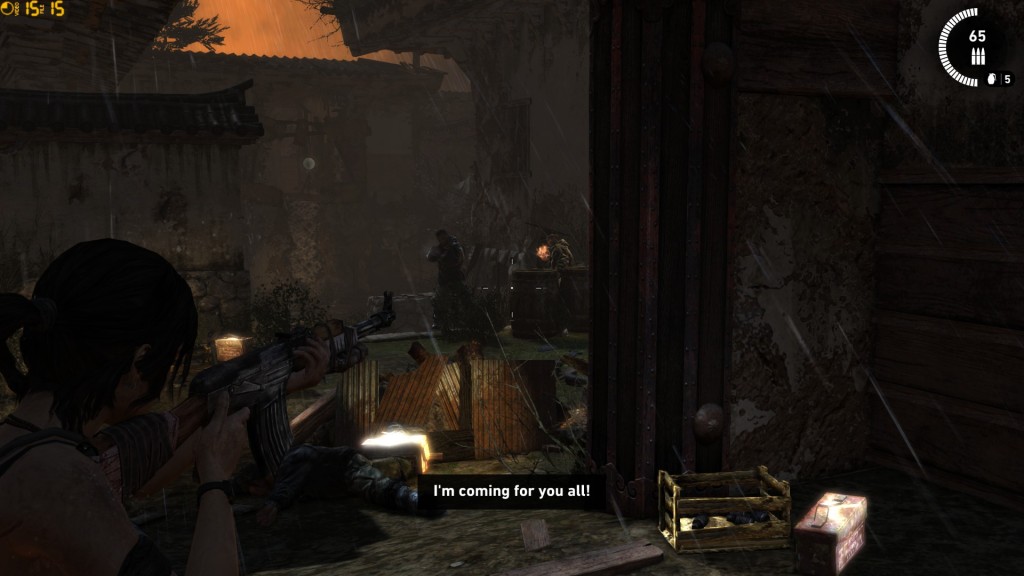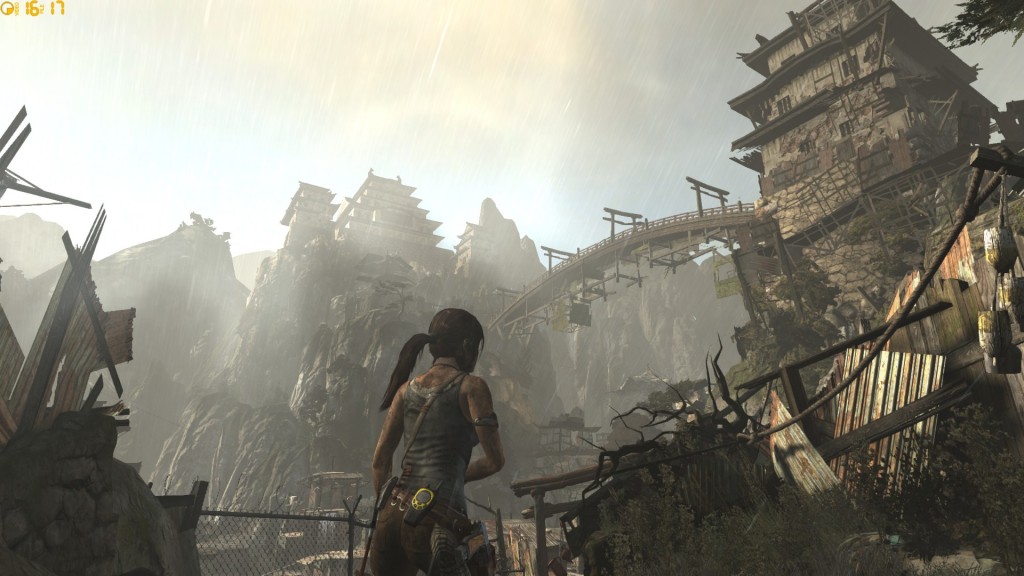- Tomb Raider: More brain & less brawn, please
- Tomb Raider – The Very Quick Verdict (and a reflection on cover shooting)
After finishing Tomb Raider, I’m happy with the gameplay appraisal I posted halfway through. This is a title that’s not sure whether it wants to be “the subtle tale of a young woman using her wits to survive… or a summer blockbuster, long on explosions and short on brains.” There is a fair amount of running and jumping and climbing about, as much of a pleasure as it was in Assassin’s Creed; there are puzzles whose solutions made me feel quite pleased with myself; and there is a lot of third-person cover shooting, too much and too repetitive for my taste (and with some downright aggravating ‘watch pattern -> dodge -> counterattack -> repeat’ closed-arena boss fights).
I do want to home in on one word in that last sentence – “cover”. In a game that derives so much of its appeal from the main character’s agility, I am not convinced that cover shooting was the best way to handle combat. Taking cover, by definition, deprives Lara of her agility; and while she has to move from cover to cover (enemies will lob Molotov cocktails or grenades if she stays still too long), a brief scramble to the next waist-high obstacle pales next to the freedom of the game’s non-combat segments. TR does contain a tantalising “what might have been” moment – one particular sequence is a lot closer to old-fashioned run-and-gun shooters, and it’s amazing what a difference that made to my enjoyment. Suddenly I could sprint! Retreat! Climb up and climb down! Fall back to a previously cleared section! Why even stop there? In a game with this many cliffside jumps and ziplines – see the above screenshot – couldn’t Lara have, say, an unlockable ability to aim her pistol in bullet time and shoot while in mid-air (a la one skill in Sleeping Dogs), or while shimmying along a rope? Surely the designers could have done better than the parade of shooting galleries that did make into the game.
From a storytelling perspective, TR’s predictable and oddly paced plot was a disappointment. And while the game was marketed heavily on the basis of Lara’s character growth – from frightened everywoman to hardened action survivor – I have reservations about how it encourages the player to exult in Lara’s growing bloodlust. (I played Spec Ops: The Line a few months earlier, and the contrast with Tomb Raider is jarring! This might well deserve an article of its own…) To me, the real star was the harsh, beautiful island on which Lara found herself trapped. There are some splendid environments in TR, both natural and man-made; and it was genuinely interesting to piece through the back-story documents left by those who came before Lara.
Overall, Tomb Raider is a game that a cover shooter buff would probably have enjoyed more than I. For me, TR was decent to good, but not great – with hindsight, I would have waited for the Steam sale instead of paying full price. Still, I’ll be interested to see what developer Crystal Dynamics works on next — hopefully, the next Tomb Raider game will build on this one’s strengths and avoid its weaknesses.
Technical note: While I played this game on PC, I used an Xbox 360 controller throughout.
Resources
Buy Tomb Raider from Amazon US
The basis of my review
Length of time spent with the game: 19 hours.
What I played: The entire story. I finished the game with 73% completion, having found most of the documents that interested me and solved all the optional tombs bar one.
What I didn’t play: Multiplayer.
Discover more from Matchsticks for my Eyes
Subscribe to get the latest posts sent to your email.













Peter,
Gunplay by its very nature doesn’t allow for much interplay (back and forth interactions) and so there are no interesting decisions to be had, as you mentioned in your first article. By comparison, in Resident Evil 4, a well placed shot can stun an enemy, which can then be fly kicked to knock them into a crowd and stall for time or slashed with the knife to conserve ammo, etc. etc.. Through the interplay, the player can make decisions and express themselves. I haven’t played Tomb Raider, but it sounds like Uncharted 2, binary interactions: move reticle through 2D space and push a button.
Your suggestion that you could tie the acrobatics into the combat is a great idea for adding more interplay into the combat. Lara could jump ontop of targets from a high ledge and then slowmo some headshots or rebound off walls etc. Perhaps my ideas are a bit extravagant given the game’s attempt at realism, but you get the point.
Great reads these two articles.
Thanks for the feedback, Daniel! Glad you liked my Tomb Raider writeup. :D
It’s interesting to hear your description of RE4 – that’s a franchise I’m not familiar with. I think you hit the nail on the head with this comment: “move reticle through 2D space and push a button.” That is the problem with plain, unadorned cover shooters (Tomb Raider, Spec Ops: The Line). At least with run-and-gun shooters, you get a new choice (move left/right/up/down). It’s even better when the game gives the player special powers (Deus Ex: HR, Bioshock Infinite, etc), as this adds another layer of choice.
I think your idea for acrobatic combat would work well! Realism wouldn’t be a barrier – this is a game in which Lara mows down a small army by herself. They’d add more choice to each battle. And they’d give the game a really cool cinematic feel.
Well, Gears of War is a cover shooter too, but it also has good interplay. So, for example, you stun an enemy and then run over and take them hostage or mow them over with a chainsaw. Having a cover mechanic doesn’t mean you can’t have back and forth interactions.
To be more specific with my original comment, you can’t get much variation with targeting in 2D space. Interplay allows for more variation (do I chainsaw or take him hostage?), which goes to your point about additional mechanics, like the examples you mention. When these mechanics then layer together, and the game world is challenging the player to pair up mechanics and interactions, you have a shooter with more legs (variation and expression).
Thanks for the explanation! I stand corrected – I’m pretty new to cover shooters and I’ve never played Gears of War. You’re right, it’s better to look at the issue in terms of interplay between available interactions. :)